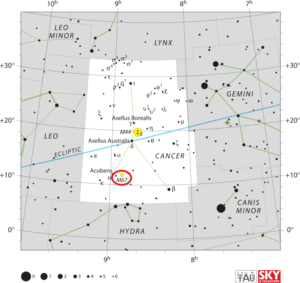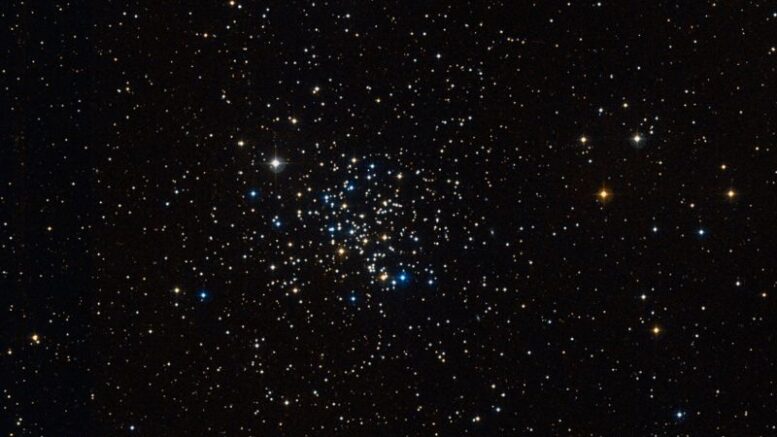Messier 67, nicknamed the King Cobra Cluster, is an open cluster located in the northern constellation Cancer, the Crab. Estimated ages of M67 place it roughly 3.2 and 5 billion years old, which would make this clusters one of the oldest clusters known. And at a distance of roughly 2610 and 2930 from Earth, it is the closest of any of the older open star clusters.
| Description | |
| Visible From Pacific Northwest | November to April |
| Best Time To Observe | January and February |
| Minimum Size Of Viewing Device | Small Telescopes |
| Object Type | Open Cluster |
| Designations | Messier 67, M67, NGC 2682, C 0847+120, Collinder 204, HR 3515, OCl 549.0, MWSC 1585 |
| Right Ascension | 08h 51.4m |
| Declination | +11°49′ |
| Constellation | Cancer |
| Number Of Stars | More Than 500 |
| Apparent magnitude | +6.1 |
| Apparent dimensions | 30′ |
| Object Radius | 10 light years |
| Distance From Earth | 2.61 – 2.93 million light years |
History
Messier 67 was discovered by the German astronomer Johann Gottfried Koehler in 1779. He described it as a “rather conspicuous nebula in elongated figure, near Alpha of Cancer.”
Charles Messier independently discovered the cluster and added it to his catalogue on April 6, 1780. He was able to resolve it into individual stars and described it as a “cluster of small stars with nebulosity, below the southern claw of Cancer. The position determined from the star Alpha [Cancri].”
William Herschel observed M67 several times. After seeing it in his 20-foot telescope in 1784, he described it as a “most beautiful cluster of stars; not less than 200 in view.”
John Herschel catalogued the cluster as h 531 in 1826 and later added it to the General Catalogue as GC 1712. He noted, “Remarkable; cluster; very bright; very large; extremely rich; little compressed; stars from the 10th to the 15th magnitude.”
Locating M67 In The Sky
Messier 67 can be found roughly halfway and slightly above the imaginary line connecting the bright stars Regulus in Leo and Procyon in Canis Minor.
The cluster lies only 1.75 degrees west of Acubens, Alpha Cancri, a multiple star system with a visual magnitude of 4.20. Acubens is located about 9 degrees southeast of Messier 44, the famous Beehive Cluster.

Viewing M67
Small 10×50 binoculars show the cluster as an elongated patch of light, while small telescopes reveal its brightest stars. 6-inch and 8-inch instruments resolve dozens of stars, while 12-inch telescopes reveal about 100 individual stars in the cluster. The best time of year to observe M67 from northern latitudes is during the late winter and early spring.
Photographing M67
Messier 67 is a star cluster that has many of its stars spread out in space, therefore, it is highly recommended to image it using a wide field of view to get all of the different stars in the shot. Accurate autoguiding will be crucial to maintain crisp images of the cluster. There are a plethora of available photographs on astrobin and cloudy nights to help find a similar build as yours, but the target isn’t necessarily one popular enough to blog about for many astrophotographers.
A quick on on clusters, which can be easier to image if one has a quality refractor. Short exposures are the best option for globular clusters for imaging as short exposures will not saturate the star cores and it is far easier to preserve the star colors both in the cluster itself and in the surrounding sky.
https://www.skyatnightmagazine.com/news/messier-67/
http://cs.astronomy.com/asy/m/starclusters/492670.aspx
Sources And Further Reading
Descriptions of all of Messier Objects can be found here.
https://www.messier.seds.org/m/m067.html
https://freestarcharts.com/messier-67

Be the first to comment on "Messier 67 King Cobra Cluster"